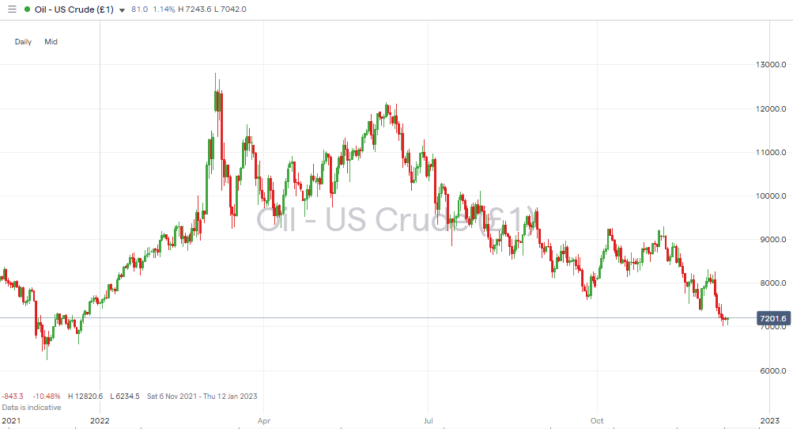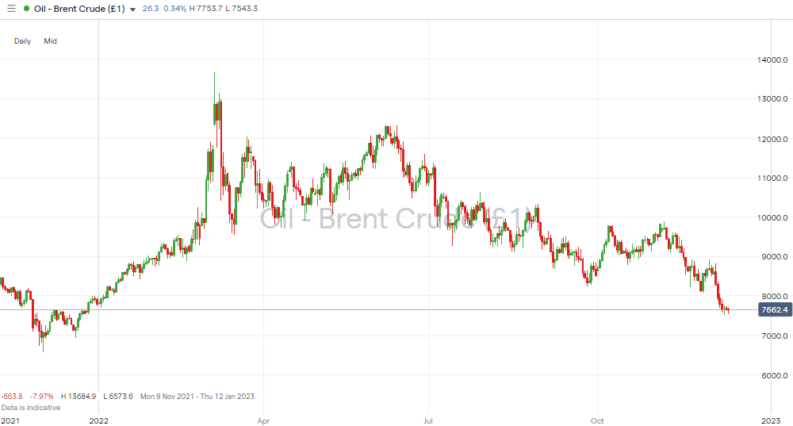From the fuel in the vehicles that we drive to heating oil that warms our homes, oil is one of the world’s most widely used natural resources.
The complex structure of supply and demand factors in the market results in dramatic swings in the oil price. That, in turn, attracts traders who speculate on which way price might next head. If that is something you have a view on, read on as this guide breaks down how to trade this commodity.
OPEC members meet monthly to discuss market conditions and with the aim of finding a consensus on production level targets. Oil traders treat these meetings as a time to prepare for additional volatility in the crude markets. The decisions of senior ministers are able to cause dramatic price swings.
How to Trade Oil
If you’re following developments in the oil market and have a view on which way price is heading, then the good news is that there are several ways to trade oil. Getting to grips with how to trade oil starts with understanding the core element of the market.
Due to the large amount of capital infrastructure required to produce oil, the market in crude is dominated by huge corporations. Saudi Arabian oil giant Aramco (SAR) is a public petroleum and natural gas company based in Dhahran, which often has the largest market capitalisation of any listed company.
Other big corporations that produce, store, and supply oil to consumers and business partners trade crude oil physically. It is generally transported through pipelines or shipped, and oil futures are traded on exchanges where industrial buyers and sellers strike deals to take physical delivery of the product.
The Chicago Mercantile Exchange (CME) supports trading in oil futures and attracts multinational corporations, big banks, hedge funds and some retail investors. But futures trading isn’t for everyone.
Physical futures require participants to take physical delivery of the oil on expiry date. Should you forget to sell out of your position in time, you’ll be committed to taking delivery of crude oil. Futures trading can also be relatively expensive in terms of transaction costs and the high margin requirement is another barrier to entry.
Contracts for Difference (CFDs) are instruments that offer a more user-friendly way for retail investors to trade oil. CFDs are binding agreements between brokers and their clients where one will agree to pay the other the difference on the buy and sell price of a trade.

YOUR CAPITAL IS AT RISK
Both Brent and WTI oil can be traded in CFD form. The price will be determined by that in an underlying market, probably using a live feed from the CME exchange. The price quoted by a broker will reflect the live market price, but as they are acting as an intermediary, they are able to offer their customers the option to trade in smaller size, sell short, or use leverage.
Exchange Traded Funds (ETFs) are another way to trade and speculate on the direction of oil prices. These fund-style products hold a basket of oil futures or stocks of firms connected to the sector. They are priced in real-time, so it’s possible to hold them for short periods of time as part of a speculative strategy or hold them as long-term investments.
Another way to gain exposure to events in the oil market is to buy stocks in firms that are impacted by changes in the price of crude. These could be producers such as Shell (LSE:SHEL) or service companies such as ABB Group (NYSE:ABB), which offer a ‘picks and shovels’ approach to investing in oil.
Increased interest from investors and the revolutionary technology used by online trading platforms has resulted in more retail investors trading oil. They can use state-of-the-art CFD platforms, which allow them to trade oil CFDs, ETFs and stocks in an easy and cost-effective manner.
Online brokers now offer their clients platforms that work on desktop and handheld devices and have intuitive functionality as well as a range of powerful software tools. There are research tools that cover both technical and fundamental analysis and a wide selection of other timesaving and risk-management features to help you trade.
Oil Trading Strategies
Investors can use any of the above trading instruments to trade the oil markets. The next step is developing a view on which way price might be heading.
You can quickly gauge the supply and demand by analysing historical inventories as part of fundamental analysis. Each week, the EIA updates inventory data after it releases its production and demand estimates.
Traders might consider looking at the trajectory of inventories to determine future price movements. When the trajectory is trending lower, prices should be rising. As the trajectory of inventories is rising, prices should be falling.
Another strategy is to evaluate market sentiment. You can look to see what hedge funds are doing weekly by evaluating the Commitment of Traders report issued by the Commodity Futures Trading Commission. This report shows you what those who are trading futures have transacted.
When funds are adding, it’s usually a bullish sign. When they are reducing long positions and adding to short positions, this is a bearish signal.
Another type of strategy is to use technical analysis. This is the study of past price movements to determine future price action. Technical analysis strategies can be applied to any market and ones that are popular with oil traders include momentum and mean reversion strategies.

YOUR CAPITAL IS AT RISK
What is Crude Oil?
Crude oil is a fossil fuel formed from a mixture of hydrocarbons that were created from the remains of animals and plants that lived hundreds of millions of years ago.
The pressure created through layers of rock and sand combined with heat eventually form what we know today as crude oil. Crude oil can exist in both liquid and gaseous forms in underground reservoirs, as well as in sedimentary formations and near the Earth’s surface in tar sands.
The majority of trade in the global crude oil market is based on two products that are similar but different. Brent oil is a light sweet oil that is used to produce many different types of distillates, including Gasoil and Kerosene. Brent is an oil that is priced in Europe, and 65% of the world’s oil is pegged to this price.
West Texas Intermediate oil (WTI) is a North and South American crude oil benchmark, priced in Cushing Oklahoma, in the United States. WTI is light crude oil because of its relatively low density and its low sulphur content. WTI is refined into gasoline, as well as distillates such as heating oil and diesel fuel.
As opposed to Brent oil, WTI can be produced in any location as long as it conforms to the specifications of the oil.
Crude Oil Demand and Supply
The market price of Brent and WTI typically differs slightly. They’re slightly different products and are traded in different regions of the world. On the whole, they move in tandem when the supply and demand factors, which influence the industry, come into play.


YOUR CAPITAL IS AT RISK
Demand for oil stems from its use in industrial activity. It is a benchmark transportation fuel used around the globe to facilitate commerce. Oil is refined into gasoline to fuel cars as well as diesel for the movement of trucks and trains. It can be refined into residual fuel for large ships, as well as light ends to make plastics and chemicals, as well as many lubricants.
Demand is generally a function of global economic growth. As economic growth expands, oil demand usually rises. As global economic growth contracts, oil demand usually declines.
According to the International Energy Agency (IEA), the US sources oil from as many as 73 countries around the globe. The US is itself the top producer of crude in the world, and amongst its top oil trading partners, it includes Canada, Mexico, Saudi Arabia and Colombia.
The supply of oil has historically been a contentious issue. As a commoditised product, crude from one source can be easily replaced from another, and in a buyers’ market, those producing oil can find themselves competing against each other and driving price down.
The Organization of the Petroleum Exporting Countries, OPEC, and OPEC+ are cartels of oil-producing countries that work in conjunction to manage the supply of oil to the global markets and thereby keep prices high. They allocate production quotas to members, which, if stuck to, ensure revenues are optimised.
Final Thoughts
Oil markets can be risky to trade. Geopolitical risk levels and weather patterns play a big part and can change in an instant. Factor in the crucial role oil plays in the economy and any restrictions to supply can be followed by dramatic price surges.
The move towards renewables is another trend to consider. Oil is considered one of the worst of the carbon fuels, and despite the current need for the commodity, public opinion is turning away from its use.













